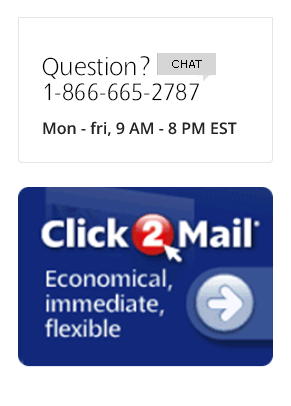Step 3 on the 12-step path to a successful direct mail campaign is to build (and maintain) a good list. Of all the pieces of a direct mail campaign, your list is the single most important. Having a well-built, well-managed list can dramatically reduce costs and boost the effectiveness of your direct mail.
Building an in-house list
Marketers refer to a list that you build “organically” (in other words, not by buying or renting it) as an in-house list. Names on an in-house list should come from prospects who have expressed interest, current and past customers, referrals, and (when appropriate) people in your “sphere of influence”– personal contacts who may be interested in your product or service. Take these steps to more effectively build your in-house list:
• Have a “sign up for our mailings” form on your website. These are most often used to build e-mail marketing lists, but they can just as easily be used to build direct mail lists. Many website hosting companies offer an off-the-shelf sign-up form which can be linked to an Excel file or database that you can use to build a list of prospective customers.
• Ask your customers. Even if you don’t get your customers’ names and addresses in the normal course of doing business with them, ask for the information (including full names and mailing addresses, telephone numbers, e-mail addresses, and birthdays or anniversaries, when appropriate – the more information, the better).
Buying or renting a list
Buying or renting a list from a third party can be a great way to supplement your in-house list; perhaps because you’re reaching out to a new demographic, or perhaps you’re just getting started and haven’t built a sizable in-house list yet. Take these steps to make your list buying or renting process an easy one:
• Decide on your goal. What is the goal of your direct mail campaign? Based on that goal, who do you want to target? Having a clear target in mind is essential in ensuring that you get the most effective mailing list.
• Compiled or direct-response? A compiled list is generated from secondary sources like the phone book, the Internet, and public records (magazine subscription and credit card lists are also popular ways to generate compiled lists). A direct-response list is made up of people who have responded to an offer of some kind (by mail, telephone, online, or some other way). Direct-response lists are widely considered to be the best – you can market to consumers and businesses who have already responded to organizations similar to yours and once a response is received, the name of that prospect goes on your in-house list
• Buy or rent? Most small businesses rent their prospecting lists because it is both less expensive and less involved than owning (and, consequently, managing) your own list. Most lists “go bad” at the rate of 2 percent per month (at the end of the year about a quarter of most lists are out of date), so if you choose to own your prospecting lists, you’ll have to invest in their upkeep.
• Owner, manager or broker? A list broker is an agent who coordinates the rental of mailing lists between the list owners and renters (much as a real estate broker coordinates a deal between a buyer and a seller). A good list broker like Click2Mail will have access to a wide range of high-quality lists and the necessary knowledge to help you choose the best list based on your campaign goals and your target recipient.
You’ve got your list. Now what do you do with it?
• Segment and target. Over time, you should use the information you gather as you do business with your customers and develop relationships with prospects to build a deeper, richer portrait of them in your database. When it comes to personalizing your direct mail, the more you know about your customers and prospects, the better.
With variable data printing (Click2Mail offers this option, click here to find out more), it is easy to change the elements of a mailer to target individual customers and prospects (with information about their expressed interests, the last product they purchased, or an upcoming birthday, for example). The benefits of that kind of personalization are clear: evidence shows response rates increase as much as 1500%.
• Track and test. Whether you’re using a list from a broker or your own in-house list, tracking responses is an important way to reduce the cost and improve the effectiveness of future mailings. Tracking response rates on your in-house list will help you maintain up-to-date records and design more effective mailers. Tracking response rates on mailed lists will help you and your broker hone in on the types of recipients that are best to target, and the messages that are most effective.
Click2Mail is here to help you on your path to a successful direct mail campaign. Remember, the quality of your result is directly linked to the quality of your list. We can help you purchase or rent an external list, or advise you on building your own. Visit Click2Mail’s online Mailing List Center today. (And, for more information, check out our recent webinar on creating and managing your mailing list.)





